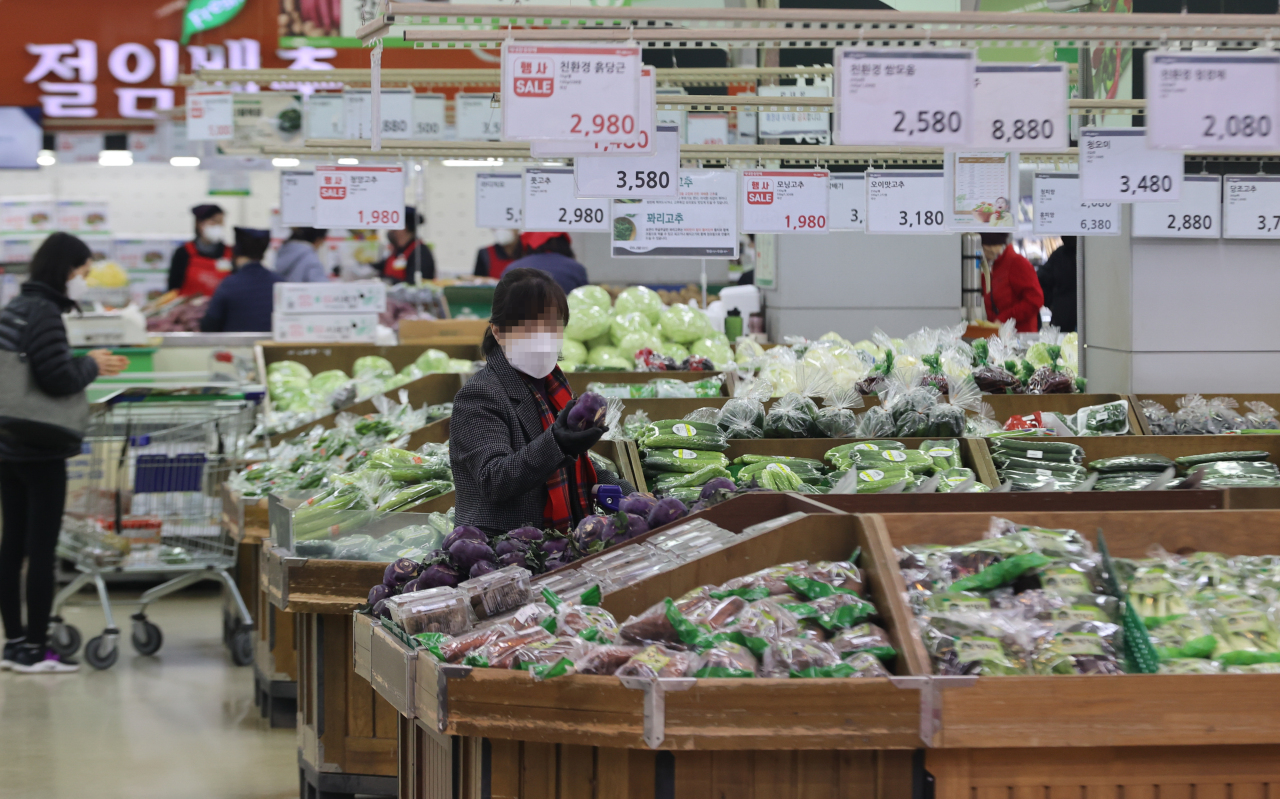Low-income households suffer more from inflation: report
By Choi Si-youngPublished : March 21, 2022 - 15:57

South Korea’s low-income households in the bottom 20 percent have been hit harder by COVID-19-induced inflation than high-income households in the top 20 percent, due to a sharper surge in essential spending on food, housing and utilities than in discretionary spending, a local think tank said Monday.
Between 2018-2019 and 2020-2021, consumer prices rose 2.7 percent for the bottom 20 percent, about 1.4 times more than that of the top 20 percent at 1.9 percent, according to the Korea Economic Research Institute. The institute used a weighted price index to account for spending patterns of each group.
In the period surveyed, food, housing and utility prices, which account for key areas of spending for the lowest 20 percent, jumped an average of 3.7 percent. Meanwhile education, transportation and lodging prices, which top the list on bills for the highest 20 percent, all soared an average of 0.7 percent.
“The low-income households bear the brunt of high inflation as they spend more on what they have always spent most, like food and housing. They need more money flowing in and they need jobs to do that,” said Choo Kwang-ho, head of the economic policy department at the KERI.
Taming food inflation involves streamlining the way food is delivered to consumers in the long term, Choo added, saying in the short term the standoff over peace talks on Ukraine could keep pushing up prices unless a resolution is reached.
Recent customs data showed that Korea’s grain import prices hit a record high in December last year as the Russia-Ukraine crisis worsened. Russia is the world’s top wheat exporter while Ukraine is one of the four major corn exporters globally.
Grain imports cost the government $849 million in November and $895 million in December last year, hitting a record high in the last month before sliding to $838 million in January this year, according to the Korea Customs Service, which began compiling the data in 2000.
It was the first time Korea‘s expenditure spent on imported grains exceeded $800 million for three straight months.
The Ministry of Agriculture, Food and Rural Affairs has said that it was closely monitoring the situation and that it would work to cushion the impact of an extended standoff, as geopolitical tensions continue to unsettle commodity prices worldwide.
The Food Ministry was recently blamed for being grossly ineffective in dealing with runaway inflation when its online website disclosing fast-food chain prices and other common food items like gimbab proved less popular than expected.
The website, revealed in late February to heap pressure on companies to rein in a price hike, is misguided, according to Sung Tae-yoon, an economics professor at Yonsei University,
“The government should rather think about reaching out to companies to help them reduce costs,” Sung said.
Between 2018-2019 and 2020-2021, consumer prices rose 2.7 percent for the bottom 20 percent, about 1.4 times more than that of the top 20 percent at 1.9 percent, according to the Korea Economic Research Institute. The institute used a weighted price index to account for spending patterns of each group.
In the period surveyed, food, housing and utility prices, which account for key areas of spending for the lowest 20 percent, jumped an average of 3.7 percent. Meanwhile education, transportation and lodging prices, which top the list on bills for the highest 20 percent, all soared an average of 0.7 percent.
“The low-income households bear the brunt of high inflation as they spend more on what they have always spent most, like food and housing. They need more money flowing in and they need jobs to do that,” said Choo Kwang-ho, head of the economic policy department at the KERI.
Taming food inflation involves streamlining the way food is delivered to consumers in the long term, Choo added, saying in the short term the standoff over peace talks on Ukraine could keep pushing up prices unless a resolution is reached.
Recent customs data showed that Korea’s grain import prices hit a record high in December last year as the Russia-Ukraine crisis worsened. Russia is the world’s top wheat exporter while Ukraine is one of the four major corn exporters globally.
Grain imports cost the government $849 million in November and $895 million in December last year, hitting a record high in the last month before sliding to $838 million in January this year, according to the Korea Customs Service, which began compiling the data in 2000.
It was the first time Korea‘s expenditure spent on imported grains exceeded $800 million for three straight months.
The Ministry of Agriculture, Food and Rural Affairs has said that it was closely monitoring the situation and that it would work to cushion the impact of an extended standoff, as geopolitical tensions continue to unsettle commodity prices worldwide.
The Food Ministry was recently blamed for being grossly ineffective in dealing with runaway inflation when its online website disclosing fast-food chain prices and other common food items like gimbab proved less popular than expected.
The website, revealed in late February to heap pressure on companies to rein in a price hike, is misguided, according to Sung Tae-yoon, an economics professor at Yonsei University,
“The government should rather think about reaching out to companies to help them reduce costs,” Sung said.









![[Kim Seong-kon] Democracy and the future of South Korea](http://res.heraldm.com/phpwas/restmb_idxmake.php?idx=644&simg=/content/image/2024/04/16/20240416050802_0.jpg&u=)








![[KH Explains] Hyundai's full hybrid edge to pay off amid slow transition to pure EVs](http://res.heraldm.com/phpwas/restmb_idxmake.php?idx=652&simg=/content/image/2024/04/18/20240418050645_0.jpg&u=20240418181020)

![[Today’s K-pop] Zico drops snippet of collaboration with Jennie](http://res.heraldm.com/phpwas/restmb_idxmake.php?idx=642&simg=/content/image/2024/04/18/20240418050702_0.jpg&u=)